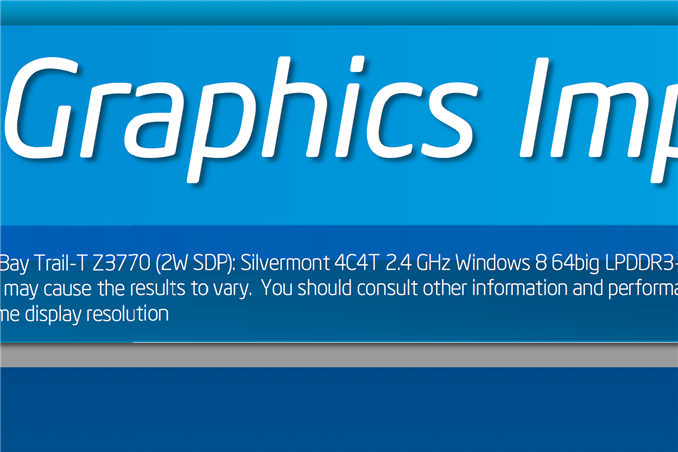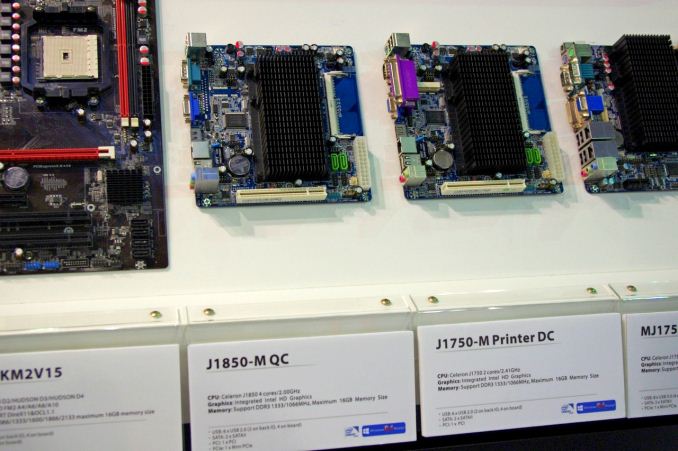Silvermont to Sell under Atom, Celeron and Pentium Brands, 2.4GHz Z3770 Leaked
by Anand Lal Shimpi on June 9, 2013 7:28 PM EST- Posted in
- CPUs
- Intel
- Atom
- Silvermont
- Trade Shows
- Computex 2013

During Computex a bit of Intel news leaked out that I didn't have time to talk about. Now that I'm back in the US, it's time to play catch up. As Silvermont is expected to drive up the performance stack, Intel will sell the core under Atom, Celeron and even Pentium branded processors. This is very similar to how AMD took Jaguar this generation and used it with both E-series and A-series branding.
Thanks to a great tip on Twitter (thanks Ashraf!), it looks like Intel's Hermann Eul (the new head of the mobile & comms group) leaked specs for the first official Silvermont SKU: the Z3770. It's unclear if this part will be branded Atom, Celeron or Pentium though. The quad-core SKU features a max CPU clock of 2.4GHz and carries a 2W SDP (Scenario Design Power) rating. Keep in mind that SDP is a thermal rating based on a different set of benchmarks than Intel's TDP ratings, so it's entirely possible for the chip to peak (and sustain) at higher thermals depending on usage model and how the OEM has configured the power profile of the chip. Previous generation Atom cores carried similar if not lower TDPs, which could mean that with Silvermont we're going to see a wider dynamic range of power consumption. We've seen this trend towards greater dynamic range in power consumption for a while now. The devil is really in the details of how power management is implemented. Silvermont takes a step towards Core-like power management, but we'll have to see how that ends up surfacing in final products.
Ian also found some examples of Celeron branded Silvermont desktop mini-ITX motherboards at Computex from Wibtek. There's the Celeron J1850 (4C/2.0GHz) and Celeron J1750 (2C/2.4GHz):
Intel claims Silvermont will deliver substantially better performance and power consumption than current (and upcoming) ARM based SoCs. I always like to point out that literally every single SoC vendor has told me that they lead in performance per watt. Today, as best as I can tell, Qualcomm is the rightful owner of that crown. Later this year we'll really find out if Intel takes it back.











17 Comments
View All Comments
Wilco1 - Monday, June 10, 2013 - link
3W TDP seems unlikely at 2.4GHz. Anand's measurements on Z2760 show CPU+GPU having ~2W TDP. Now imagine doubling the core count, 33% higher frequency and a faster GPU. The 22nm process helps of course, but the disappointing reduction in active power from SB to Haswell shows it's not magical. So increased performance means increased power.As for performance, based on the estimates given it looks like Silvermont will have worse IPC than Cortex-A15. Although it may win Sunspider, that's one of the few benchmarks where Atom appears to do well.
MrSpadge - Monday, June 10, 2013 - link
Of course not. The real questions are "what performance can you put into a given TDP" and "how much energy is used to complete a given task". TDP tells nothing about these.frogger4 - Monday, June 10, 2013 - link
Am I the only one wondering about the Z3770 branding? I suppose the idea is that this the top end Silvermont part, like how the i7-3770 was the highest performing Ivy Bridge part? I am unsure for whom this sort of marketing is for (I'd love to see a numbering system like what GPU manufactures use but from CPU companies).dealcorn - Tuesday, June 11, 2013 - link
I do not believe that the Z3770 is a Baytrail-T SoC. Baytrail-T lacks SATA and it's specifications lack reasonable functionality (eg a free PCI-e lane) to support the SATA solution shown on several of the motherboard images. More likely, this is a Baytrail-M SoC.Intel's margins on this product are likely lots better than the feature stripped Core chips Intel traditionally pitched to this segment of the market. Slap this 2W SDP SoC into a tablet with a SSD that supports DEVSLP and this is a potent weapon in the battle for Android device market share. The price is higher than Baytrail-T solution but the SoC is better in ways some folks may be willing to pay for.
dwade123 - Tuesday, June 11, 2013 - link
ARM's future is only death. And maybe in cheap Chinese knockoff phones.MustafaK - Tuesday, June 11, 2013 - link
today arm is used in multiple times more devices then x86. every single calculator and soooo many more devices have arm chips in them. inside of just about every desktop there is atleast one arm chip. hard drives have arm chips inside of them. so please stop being sillyspeculatrix - Tuesday, July 23, 2013 - link
Yes, arm is the probably the dominant general purpose cpu in the world now.. provided they continue to innovate and offer a whole range of products covering a wide range of performance, power efficiency, cost and integrated features, then Intel have a near impossible task to break their stranglehold.